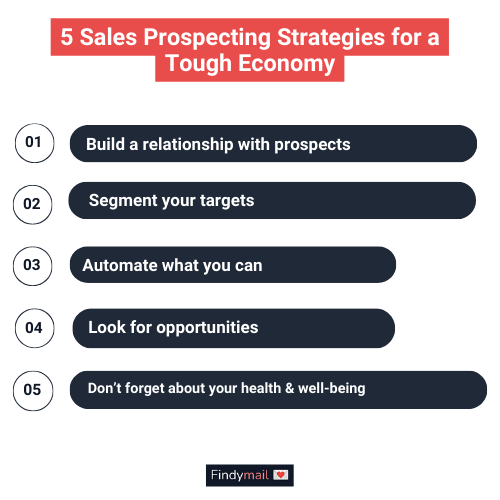Looking at the current state of affairs, it's hard to ignore the signs of a looming recession. We're coming off the heels of a global pandemic, and political turmoil seems to be the order of the day.
To top it all off, rising inflation is affecting everyone’s bank account. It's no wonder the World Bank predicts that the recession will hit full swing in 2023. Brace yourselves, folks.
Now, you might be thinking, "How does this affect me as a salesperson?"
It’s simple– the impact of an economic downturn ripples through all industries. From large corporations to individuals trying to make a living doing their own thing, everyone is feeling the pinch.
But with the right attitude, you can handle anything the world throws at you. In this article, I’m going to equip you with the tips and tricks you need to weather the storm.
So, tighten your bootstraps, adjust your mindset, and let's dive into the top sales prospecting strategies that will help you not just survive but thrive in a tough economy.

1) Build a Relationship with Prospects
When it comes to doing business, people naturally prefer to work with someone they know and trust. It's human nature.
But building a solid relationship with your prospects is a whole different ball game. It takes time, effort, and a genuine commitment to understanding their needs and earning their trust.
Here's a shocking statistic for you: only 44% of sales reps follow up once after the initial contact, and a staggering 94% fall off after just four attempts. Can you believe that?
It's like they expect a golden opportunity to fall into their laps without putting in the necessary work.
But here's the kicker: a whopping 80% of closed deals require at least five or more follow-ups. Those successful deals don't just happen overnight.
They’re the result of persistent, consistent, and meaningful follow-ups that build a relationship and demonstrate your commitment to helping your prospects succeed.
So, how do you build that relationship? It starts with personalized interactions. Take the time to understand your prospects' pain points, challenges, and goals. Show genuine interest in their business and ask thoughtful questions.
Remember, building a relationship takes time, but it's time well spent. Be patient, stay persistent, and don't give up after a few tries.
As I recently explained on LinkedIn, lead with value with follow-up emails like:
2) Segment Your Targets
You need to laser-focus your prospecting efforts on industries and individuals who are most likely to continue buying your product/service.
During a market boom, everyone can be your customer. But the reality shifts during a recession. It's time to get strategic and narrow down your target audience.
You can make a thousand dials, send countless emails, and conduct numerous outreach activities, but if they're to prospects who simply can't buy, it's all wasted effort.
Start by analyzing your existing customer base and identifying those who have proven to be resilient during tough economic times.
What industries are they in? What specific characteristics or needs do they share?
Where are they located? Some areas are more resilient than others.
Remember, a targeted approach doesn't mean you're excluding potential customers. It means you're optimizing your effort and increasing your chances of success by focusing on those who are most likely to convert.
3) Automate What You Can
In a rough economy, where every minute counts, automation becomes an invaluable tool in your prospecting arsenal.
Automation helps you take care of tedious tasks, mitigate risks, reduce human eros, and, most important, free up your valuable time and energy to focus on activities that drive real results.
There are a plethora of automation tools available that can streamline your prospecting efforts and supercharge your productivity.
Take, for example, Apollo.io, Woodpecker, Super Send, and many more you can make part of your ultimate tech stack.
These tools offer sales automation features such as automated email follow-ups, personalization, email sequences, etc.
And you can create customized workflows, set reminders, and even integrate with your favorite CRM to keep all your prospecting efforts organized and efficient.
4) Look for Opportunities
Hard times are challenging, but they can also give opportunities to those who are willing to adapt and seize them.
The key is to identify what can bring value to people during hard times. Can you save them money or drive up their revenue?
Think about it this way: when everyone else is focused on the negatives, you can stand out by offering a solution that brings practical value and demonstrates a clear benefit.
Keep an eye out for emerging trends and shifts in the market. Industries that may have been thriving before the downturn could be struggling, while others may be on the rise.
Adapt your prospecting strategy to align with these evolving opportunities and position yourself as a valuable resource in those sectors.
Remember, during tough times, people are actively seeking ways to overcome challenges and improve their situations.
5) Don’t Forget About Your Health & Well-Being
Sales can be intense, and the pressure is real. The constant hustle, the rejections, honing your sales skills, and the long hours can wear you down. That's why you need to prioritize your physical and mental health.
Make time for self-care. Take breaks, exercise, and get enough sleep. Find activities that help you unwind and recharge.
Take care of number one, and watch how it boosts your performance and overall well-being.
Wrapping Up
Those are my 5 go-to strategies and tips for when I'm prospecting during a downturn. Now, it's time for you to put these tactics into action and make a real impact on your sales efforts.
Just remember that you keep adapting, stay creative, and refine your prospecting techniques as you go. Success during times like these requires resourcefulness and a willingness to think outside the box.
And if you need verified emails to make your prospecting a little bit easier, be sure to check Findymail! Sign up today and get 10 free emails on me!






